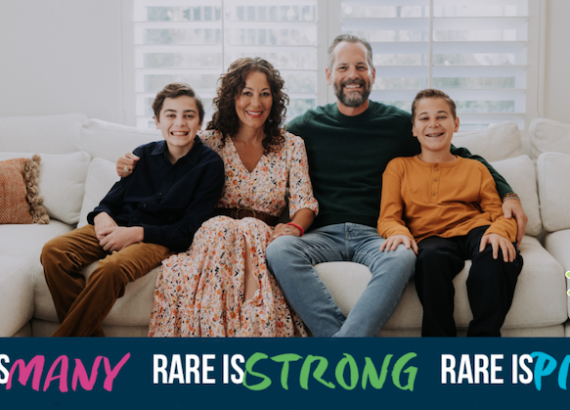Sharing Our Stories to Create Change

As we approach Rare Disease Day at the end of this month, on February 28th, I want to discuss something incredibly important: Why sharing our stories matters.
Every year on Rare Disease Day, I reflect on why my family advocates. I consider why we keep speaking up, even when it feels like we’re shouting into the void, why we keep pushing, even when change seems slow, and why, despite the challenges, we continue to believe that our voices can make a difference. Our stories matter. Let me tell you why.
One Rare Disease Day, I shared a message about why the day was personal for me. I talked about how our eyes have been opened to the needs of the rare disease community and how, sometimes, if we want things to change, we have to be the change. We have to ask for it, seek it, push for it, educate about it, and advocate for it.
Not long after posting that message, I received a response from a mother whose child had been newly diagnosed with a rare disease. This was her first Rare Disease Day, and she admitted that she didn’t really understand what the “celebration” was for.
I get that. It’s a tough thing to process. When you’re new to this world, Rare Disease Day doesn’t necessarily feel like something to celebrate—it feels like another reminder that life has changed in ways you never expected.
But after reading my post about why I was sharing my story on Rare Disease Day, she said she saw it differently. She realized that Rare Disease Day isn’t about celebrating the diagnosis—it’s about celebrating the resilience of our community and the power of our voices. It’s about being seen, being heard, and being recognized. It’s about joining in to build awareness and advocate for equity for all rare disease patients. That moment reminded me why our voices are so powerful.
Our Stories Help Other Rare Families
When you first enter this world, it can feel like you’ve landed in another universe. There’s a flood of medical terminology, an overwhelming amount of information (or sometimes a complete lack of it), and a deep uncertainty about what the future holds.
For many, the first few months—or even years—are filled with fear, exhaustion, and isolation. You’re trying to understand what this means for your child, your family, and your future, and it can feel like you’re completely alone in it.
That’s why it is so important that we share our stories. Because someone, somewhere, is right now where we were on Day One. They need to know that we are here. They need to see that there is a community waiting to embrace them. They need to see how powerful we are. And that they are stepping into a community not of victims, but of empowered advocates.
I remember when Miles was newly diagnosed, and my husband, Tony, and I went to our very first conference for Spinal Muscular atrophy. I was filled with trepidation and raw emotion. I attended all the breakout sessions, took copious notes, and learned about the disease and best care practices. I was determined to take everything I could from the conference to help my son. But even more than that, I met other parents of children with spinal muscular atrophy, whose children were older than my son, who was just two at the time. As I met them, I learned that most of them were extremely involved in the cause. They were advocating, or fundraising for critical research, or sitting on advisory boards. And I remember thinking, even in my completely shell-shocked, heartbroken state, Oh, okay, this is how we do it. We don’t lie down and die. We stand up and fight. We rise and use our voices. We become a part of the change we want to see happen.
When we share our stories, we help newly diagnosed families see that there is hope and that while this journey is incredibly difficult, it is also filled with a community that is strong. That’s why we have to keep speaking up. Our words might be the lifeline someone else desperately needs.
Our Stories Help Our Family and Friends Understand
One of the biggest challenges of parenting a child with a rare disease is the disconnect between our reality and what the outside world sees.
Many of us have had moments when family members or friends didn’t fully grasp what we go through. They may not understand the countless doctor’s appointments, our extreme lack of time, the emotional and financial toll it takes, and the constant advocacy we have to do just to get our children what they need.
Not because they don’t care. But because they haven’t lived it.
At one of our first Cure SMA fundraisers, I spoke in front of the audience and shared our journey. Afterwards, many of our friends and family who were in attendance approached me saying, “I didn’t fully understand what you’re going through and grasp the magnitude of this diagnosis. How can we help?” That moment allowed me to connect with them on a deeper level and let them into our world. People want to help—they just need to be shown how.
When our friends and family understand what it means to be a rare parent, they can step up in meaningful ways. They can become advocates alongside us. They can help amplify our voices.
The truth is, people don’t get involved with causes they don’t feel connected to. That’s just human nature. But when they see how a rare disease affects someone they love, they start paying attention.
An analysis of charitable giving trends highlighted that motivations for donating are commonly rooted in personal or emotional connections to a cause.
So, it’s important to share our stories—whether it’s for emotional support, charitable support, or social support—to be surrounded by people who care about us and understand what we’re going through.
Our Stories Show That Rare Is Everywhere
Sharing our stories on Rare Disease Day serves as a powerful tool to engage policymakers and researchers by highlighting the collective impact of rare diseases. While each rare disease individually affects a small population, collectively, there are over 10,000 rare diseases, and 1 in 10 people are affected by a rare disease in the U.S.. That’s over 30 million people in the U.S. alone and more than 300 million worldwide.
That’s why we say: Rare isn’t rare. Rare is everywhere.
This substantial number underscores the need for comprehensive policies and dedicated research efforts.
Advocacy efforts have been instrumental in driving change. For instance, the National Organization for Rare Disorders (NORD) established the Rare Disease Centers of Excellence, creating a national network of U.S. hospitals and medical institutions dedicated to diagnosing, treating, and researching all rare diseases. In its inaugural year, these centers identified the top unmet needs and barriers to care for the rare disease community and initiated working groups to develop solutions.
Also, patient advocacy groups have been pivotal in increasing funding and investment in rare disease research and therapy development. By organizing fundraising events and lobbying governments, these groups have enabled researchers to delve deeper into complex conditions, searching for breakthroughs.
This month, Rare Disease Week, hosted by Rare Disease Legislative Advocates (a program of the EveryLife Foundation for Rare Diseases), will bring together rare disease advocates from across the country to make their voices heard by their Members of Congress. Rare disease patients and parents are educated on policy proposals impacting the rare disease community and given opportunities to advocate for policy changes directly to their Members of Congress by sharing their personal stories and how their lives have been impacted by rare disease.
These are just a few examples that illustrate how personal narratives and collective advocacy can lead to improved outcomes for the rare disease community.
When we share our stories, we remind the world that rare diseases aren’t just medical conditions—they affect real people, real families, real lives.
We Share Our Stories to Leave A Legacy For Our Children
At the heart of all of this—at the heart of why we fight, why we speak up, why we advocate—is one simple truth: We do it to leave a legacy for our children.
We do it so that they don’t have to fight the same battles we do. We do it so that the next generation of rare disease families has better access to care, more treatments, and a world that sees them, values them, and supports them.
Some of us become advocates, fighting for policy changes. Others raise awareness through storytelling, blogs, and social media. Some mamas start organizations, support groups, or even fund groundbreaking research. Every effort, big or small, ripples out and creates change.
Legacy is built in everyday moments, in the love and strength we pour into our children and our community. This is how my own journey fueled me to create Rare Mamas. Because I want better for the next mom. I want her to find resources and community sooner so that she isn’t left on her own to figure it all out.
So, we are not just advocating for today. We are creating a legacy, making sure that years from now, a newly diagnosed family won’t feel as lost as we once did—because the resources, the treatments, and the support will already be in place.
How to Share Your Story and Create Change
Not every mama has to start a nonprofit or testify before Congress to make a difference. Change begins with small, meaningful steps. Here are five ways to start sharing your story and building your legacy:
- Share Your Story—Share what rare disease day means to you and spread it to your circle of influence. Whether it’s on social media or in your local community, your voice matters. Don’t underestimate the power of storytelling—it connects, educates, and inspires action.
- Support Another Rare Mama—Sometimes, the biggest impact comes from simply being there for someone else. If there’s a mother whose child was diagnosed with the same disease as yours, or a mama in your town whose child has a different rare disease. Offer to listen, share resources, or just be a shoulder to lean on.
- Educate Others—Since most people have never heard of rare diseases, advocacy must start with education. Education can take many forms, such as educating school staff, helping professionals understand your child’s condition, which improves care for future families, or organizing awareness events. By sharing facts, statistics, and best care practices, we can foster understanding and acceptance, reduce stigma, and spread knowledge about symptoms to encourage earlier diagnoses.
- Get Involved in Advocacy – Join rare disease organizations, participate in awareness campaigns, or write to lawmakers. Many policies affecting rare disease families are shaped by parents who speak up.
- Fundraise for Research – Funding research is critical for discovering treatments and potential cures. Many advocacy groups organize fundraising events, and there are multiple ways to contribute:
- Donate proceeds from a product or service.
- Utilize employer charitable matching programs.
- Ask friends, family, and colleagues to consider donating.
- Set up a crowdfunding page.
- Volunteer at or promote a fundraising event.
- Share your story at the event or in promotion pieces to inspire donors.
The Power of Unified Voices
So, take a moment to reflect—where can you contribute? How can you turn your passion into action? Your voice matters, and together, we can create lasting impact and a better future for those living with rare diseases.
This Rare Disease Day, I invite you to share your story.
Even if it’s just a social media post.
Even if it’s just a conversation with a friend.
Even if it’s just writing a letter to your local representative.
Because every single voice matters, and our children’s future depends on us using our voices now.
So let’s be loud. Let’s be seen. Let’s make sure the world knows that Rare is everywhere. Let’s keep standing together, sharing our stories, and creating positive change for our children and for all rare disease patients!

To listen to this content, check out Episode 46 of The Rare Mamas Rising Podcast







